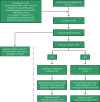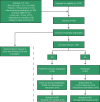Diagnostic Performance of Coronary Tomography Angiography and Serial Measurements of Sensitive Cardiac Troponin in Patients With Chest Pain and Intermediate Risk for Cardiovascular Events
- PMID: 35137790
- PMCID: PMC9368885
- DOI: 10.36660/abc.20210006
Diagnostic Performance of Coronary Tomography Angiography and Serial Measurements of Sensitive Cardiac Troponin in Patients With Chest Pain and Intermediate Risk for Cardiovascular Events
Abstract
Background: Coronary tomography angiography (CTA) has been mainly used for chest pain evaluation in low-risk patients, and few data exist regarding patients at intermediate risk.
Objective: To evaluate the performance of serial measures of sensitive troponin and CTA in intermediate-risk patients.
Methods: A total of 100 patients with chest pain, TIMI risk scores of 3 or 4, and negative troponin were prospectively included. All patients underwent CTA and those with coronary stenosis ≥ 50% were referred to invasive coronary angiography. Patients with coronary lesions <50% were discharged and contacted 30 days later by a telephone call to assess clinical outcomes. Outcomes were hospitalization, death, and myocardial infarction at 30 days. The comparison between methods was performed by Kappa agreement test. The performance of troponin measures and CTA for detecting significant coronary lesions and clinical outcomes was calculated. Results were considered statistically significant when p < 0.05.
Results: Coronary stenosis ≥ 50% on CTA was found in 38% of patients and significant coronary lesions on coronary angiography were found in 31 patients. Two clinical events were observed. Kappa agreement analysis showed low agreement between troponin measures and CTA in the detection of significant coronary lesions (kappa = 0.022, p = 0.78). The performance of CTA for detecting significant coronary lesions on coronary angiography or for predicting clinical events at 30 days was better than sensitive troponin measures (accuracy of 91% versus 60%).
Conclusion: CTA performed better than sensitive troponin measures in the detection of significant coronary disease in patients with chest pain and intermediate risk for cardiovascular events.
Fundamento: A angiotomografia coronária (ATC) tem sido usada para avaliação de dor torácica principalmente em pacientes de baixo risco, e poucos dados existem com pacientes em risco intermediário.
Objetivo: Avaliar o desempenho de medidas seriadas de troponinas sensíveis e de ATC em pacientes de risco intermediário.
Métodos: Um total de 100 pacientes com dor torácica, TIMI score 3 ou 4 e troponina negativa foram prospectivamente incluídos. Todos os pacientes foram submetidos à ATC, e aqueles com obstruções ≥ 50% foram encaminhados à cineangiocoronariografia. Pacientes com lesões < 50% recebiam alta hospitalar, receberam alta e foram contatados 30 dias depois por telefonema para avaliação dos desfechos clínicos. Os desfechos foram hospitalização, morte, e infarto agudo do miocárdio em 30 dias. A comparação entre os métodos foi realizada pelo teste de concordância kappa. O desempenho das medidas de troponina e da ATC na detecção de lesões coronárias significativas e desfechos clínicos foi calculado. Os resultados foram considerados estatisticamente significativos quando p <0,05.
Resultados: Estenose coronária ≥ 50% na ATC foi encontrada em 38% dos pacientes e lesões coronárias significativas na angiografia coronária foram encontradas em 31 pacientes. Dois eventos clínicos foram observados. A análise de concordância Kappa mostrou baixa concordância entre as medidas de troponina e ATC na detecção de lesões coronárias significativas (kappa = 0,022, p = 0,78). O desempenho da ATC para detectar lesões coronárias significativas na angiografia coronária ou para prever eventos clínicos em 30 dias foi melhor que as medidas de troponina sensível (acurácia de 91% versus 60%).
Conclusão: ATC teve melhor desempenho que as medidas seriadas de troponina na detecção de doença coronariana significativa em pacientes com dor torácica e risco intermediário para eventos cardiovasculares.
Conflict of interest statement
Potencial conflito de interesse
Não há conflito com o presente artigo
Figures




Comment in
-
Role of Computed Tomography in Excluding Acute Coronary Syndrome: is Anatomy the Way?Arq Bras Cardiol. 2022 May;118(5):903-904. doi: 10.36660/abc.20220273. Arq Bras Cardiol. 2022. PMID: 35613188 Free PMC article. English, Portuguese. No abstract available.
References
-
- Czarnecki A, Chong A, Lee DS, Schull MJ, Tu JV, Lau C, et al. Association between physician follow-up and outcomes of care after chet pain assesment in high-risk patient. Circulation. 2013;127:1386-94. - PubMed
-
- Cannon CP. Acute coronary syndromes: risk stratification and initial management. Cardiol Clin. 2005;23(4):401-9. - PubMed
-
- Haasenritter J, Aerts M, Bosner S, Buntinx F, Burnand B, Herzig L, et al. Coronary heart disease in primary care: accuracy of medical history and physical findings in patients with chest pain – a study protocol for a systematic review with individual patient data. BMC Family Practice. 2012 Ago 9;13:81. - PMC - PubMed
-
- Hamm CW, Bassand J, Agewall S, Bax J, Boersma E, Bueno H, et al. ESC Guidelines for the management of acute coronary syndromes in patients presenting without persistent ST-segment elevation. The Task Force for the management of acute coronary syndromes (ACS) in patients presenting without persistent ST-segment elevation of the European Society of Cardiology (ESC). Eur Heart J.2011;32(23):2999–3054. - PubMed
MeSH terms
Substances
LinkOut - more resources
Full Text Sources
Medical
Miscellaneous

